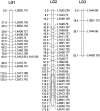Identification of QTLs Conferring Resistance to Deltamethrin in Culex pipiens pallens
- PMID: 26484540
- PMCID: PMC4617896
- DOI: 10.1371/journal.pone.0140923
Identification of QTLs Conferring Resistance to Deltamethrin in Culex pipiens pallens
Abstract
Culex pipiens pallens is the most abundant Culex mosquito species in northern China and is an important vector of bancroftian filariasis and West Nile virus. Deltamethrin is an insecticide that is widely used for mosquito control, however resistance to this and other insecticides has become a major challenge in the control of vector-borne diseases that appear to be inherited quantitatively. Furthermore, the genetic basis of insecticide resistance remains poorly understood. In this study, quantitative trait loci (QTL) mapping of resistance to deltamethrin was conducted in F2 intercross segregation populations using bulked segregation analysis (BSA) and amplified fragment length polymorphism markers (AFLP) in Culex pipiens pallens. A genetic linkage map covering 381 cM was constructed and a total of seven QTL responsible for resistance to deltamethrin were detected by composite interval mapping (CIM), which explained 95% of the phenotypic variance. The major QTL in linkage group 2 accounted for 62% of the variance and is worthy of further study. 12 AFLP markers in the map were cloned and the genomic locations of these marker sequences were determined by applying the Basic Local Alignment Search Tool (BLAST) tool to the genome sequence of the closely related Culex quinquefasciatus. Our results suggest that resistance to deltamethrin is a quantitative trait under the control of a major QTL in Culex pipiens pallens. Cloning of related AFLP markers confirm the potential utility for anchoring the genetic map to the physical map. The results provide insight into the genetic architecture of the trait.
Conflict of interest statement
Figures



Similar articles
-
Identification of protease m1 zinc metalloprotease conferring resistance to deltamethrin by characterization of an AFLP marker in Culex pipiens pallens.Parasit Vectors. 2016 Mar 23;9:172. doi: 10.1186/s13071-016-1450-4. Parasit Vectors. 2016. PMID: 27007119 Free PMC article.
-
Venom allergen 5 is Associated With Deltamethrin Resistance in Culex pipiens pallens (Diptera: Culicidae).J Med Entomol. 2015 Jul;52(4):672-82. doi: 10.1093/jme/tjv059. Epub 2015 May 29. J Med Entomol. 2015. PMID: 26335474 Free PMC article.
-
Trends in insecticide resistance in Culex pipiens pallens over 20 years in Shandong, China.Parasit Vectors. 2019 Apr 11;12(1):167. doi: 10.1186/s13071-019-3416-9. Parasit Vectors. 2019. PMID: 30975185 Free PMC article.
-
Phenotypic insecticide resistance status of the Culex pipiens complex: a European perspective.Parasit Vectors. 2022 Nov 12;15(1):423. doi: 10.1186/s13071-022-05542-x. Parasit Vectors. 2022. PMID: 36369170 Free PMC article. Review.
-
Knockdown resistance (kdr) associated organochlorine resistance in mosquito-borne diseases (Culex quinquefasciatus): Systematic study of reviews and meta-analysis.PLoS Negl Trop Dis. 2024 Aug 19;18(8):e0011991. doi: 10.1371/journal.pntd.0011991. eCollection 2024 Aug. PLoS Negl Trop Dis. 2024. PMID: 39159258 Free PMC article.
Cited by
-
Identification of protease m1 zinc metalloprotease conferring resistance to deltamethrin by characterization of an AFLP marker in Culex pipiens pallens.Parasit Vectors. 2016 Mar 23;9:172. doi: 10.1186/s13071-016-1450-4. Parasit Vectors. 2016. PMID: 27007119 Free PMC article.
-
Safety Evaluation of Various Vector Repellents in Combination with Deltamethrin in Wistar Rats.J Pharm Bioallied Sci. 2018 Jan-Mar;10(1):21-28. doi: 10.4103/jpbs.JPBS_219_17. J Pharm Bioallied Sci. 2018. PMID: 29657504 Free PMC article.
-
A novel miRNA, miR-13664, targets CpCYP314A1 to regulate deltamethrin resistance in Culex pipiens pallens.Parasitology. 2019 Feb;146(2):197-205. doi: 10.1017/S0031182018001002. Epub 2018 Jul 3. Parasitology. 2019. PMID: 29966536 Free PMC article.
-
Cytonuclear Epistasis Controls the Density of Symbiont Wolbachia pipientis in Nongonadal Tissues of Mosquito Culex quinquefasciatus.G3 (Bethesda). 2017 Aug 7;7(8):2627-2635. doi: 10.1534/g3.117.043422. G3 (Bethesda). 2017. PMID: 28606944 Free PMC article.
-
Pyrethroid-resistance is modulated by miR-92a by targeting CpCPR4 in Culex pipiens pallens.Comp Biochem Physiol B Biochem Mol Biol. 2017 Jan;203:20-24. doi: 10.1016/j.cbpb.2016.09.002. Epub 2016 Sep 11. Comp Biochem Physiol B Biochem Mol Biol. 2017. PMID: 27627779 Free PMC article.
References
-
- Mori A, Severson DW, Christensen BM. Comparative linkage maps for the mosquitoes (Culex pipiens and Aedes aegypti) based on common RFLP loci. J Hered. 1999; 90: 160–164. - PubMed
-
- Fonseca DM, Keyghobadi N, Malcolm CA, Mehmet C, Schaffner F, Mogi M, et al. Emerging vectors in the Culex pipiens complex. Science. 2004; 303: 1535–1538. - PubMed
Publication types
MeSH terms
Substances
Grants and funding
LinkOut - more resources
Full Text Sources
Other Literature Sources
Research Materials
Miscellaneous

